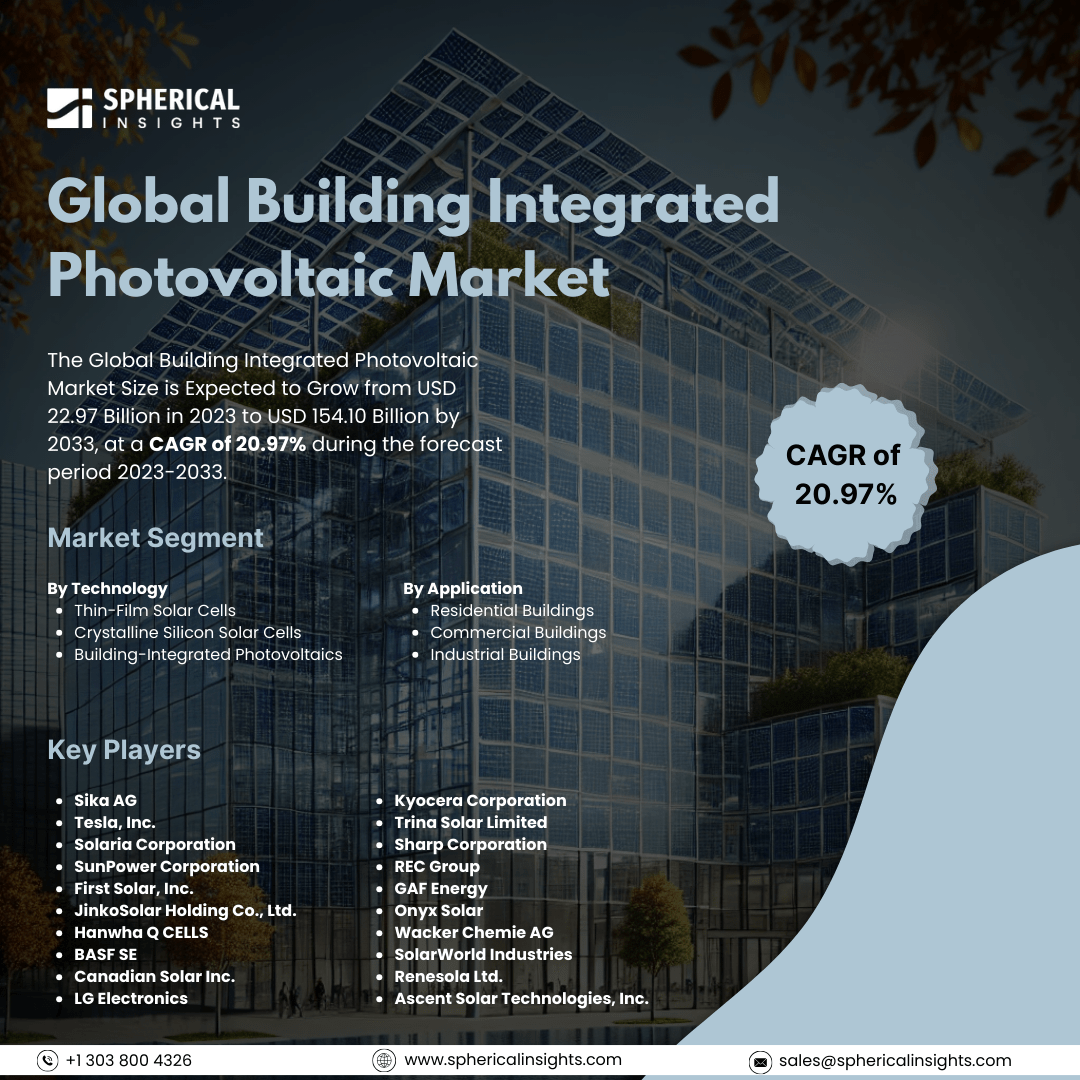Global Building Integrated Photovoltaic Market Size to worth USD 154.10 Billion by 2033.
According to a research report published by Spherical Insights & Consulting, The Global Building Integrated Photovoltaic Market Size is Expected to Grow from USD 22.97 Billion in 2023 to USD 154.10 Billion by 2033, at a CAGR of 20.97% during the forecast period 2023-2033.
Browse key industry insights spread across 210 pages with 110 Market data tables and figures & charts from the report on the Global Building Integrated Photovoltaic Market Size, Share, and COVID-19 Impact Analysis, By Technology (Thin-Film Solar Cells, Crystalline Silicon Solar Cells, and Building-Integrated Photovoltaics), By Application (Residential Buildings, Commercial Buildings, and Industrial Buildings), and By Region (North America, Europe, Asia-Pacific, Latin America, Middle East, and Africa), Analysis and Forecast 2023 – 2033.
The production and installation of solar photovoltaic (PV) modules or solar panels used as useful building materials in new or existing buildings are the activities of the global building integrated photovoltaics market. BIPV skylights, BIPV sunshades, BIPV roofing tiles or shingles, and BIPV facades made of glass and plastic are important products in this market. The adoption of green building rules that encourage zero-energy building design and the quickening shift to renewable energy sources are driving the growth of the global building integrated photovoltaics market. Rising demand for visually appealing and energy-efficient building facades, growing consumer awareness of renewable energy sources, real estate developers' increased emphasis on green construction, and favorable government policies and incentives supporting solar power generation are some of the key trends driving the market's expansion. BIPV system adoption has been aggressively encouraged by the Indian government as part of its renewable energy goals. Installing 100 GW of grid-connected solar power plants by 2022 and 300 GW by 2030 are the government's goals under the National Solar Mission. BIPV systems, which improve building sustainability and energy efficiency, are heavily supported by this program. However, the global building integrated photovoltaics (BIPV) market faces challenges due to high initial costs, innovative designs, and government incentives. To overcome these barriers, solutions must be developed to make BIPV more affordable.
The thin-film solar cells segment accounted for 37.9.1% of the market share in 2023 and is expected to grow at a significant CAGR during the forecast period.
Based on the technology, the building integrated photovoltaic market is classified into thin-film solar cells, crystalline silicon solar cells, and building-integrated photovoltaics. Among these, the thin-film solar cells segment accounted for 37.9.1% of the market share 2023 and is expected to grow at a significant CAGR during the forecast period. Thin-film solar cells are photovoltaic materials that are less expensive to manufacture than traditional silicon-based panels due to their use of less material. They are commonly used in residential building projects due to their affordability, making them a popular choice for those on a budget.
The residential buildings segment accounted for 38.28% of the market share in 2023 and is expected to grow at a significant CAGR during the forecast period.
Based on the application, the building integrated photovoltaic market is divided into residential buildings, commercial buildings, and industrial buildings. Among these, the residential buildings segment accounted for 38.28% of the market share and is expected to grow at a significant CAGR during the forecast period. This is due to the growing popularity of solar panel installation on residential facades and rooftops as a way to get renewable energy.
North America is estimated to hold the largest share of the building integrated photovoltaic market over the forecast period.
North America is estimated to hold the largest share of the building integrated photovoltaic market over the forecast period. North America's BIPV market is growing due to government incentives, energy-efficient building practices, and sustainability awareness. Major players invest in research and development, and rising residential and commercial construction projects contribute to demand. As stricter energy regulations are implemented, North America will continue to play a key role in sustainable energy solutions.
Asia Pacific is predicted to have the fastest CAGR growth in the building integrated photovoltaic market over the forecast period. China and Japan are major consumers of BIPV, with China's construction sector and rapid urbanization promoting its use in infrastructure projects. Japan's focus on renewable energy and the presence of major solar panel manufacturers like Trina Solar and JinkoSolar expand the Asia Pacific market.
Company Profiling
Major key players in the building integrated photovoltaic market include Sika AG, Tesla, Inc., Solaria Corporation, SunPower Corporation, First Solar, Inc., JinkoSolar Holding Co., Ltd., Hanwha Q CELLS, BASF SE, Canadian Solar Inc., LG Electronics, Kyocera Corporation, Trina Solar Limited, Sharp Corporation, REC Group, GAF Energy, Onyx Solar, Wacker Chemie AG, SolarWorld Industries, Renesola Ltd., and Ascent Solar Technologies, Inc., and Others.
Recent Development
- In October 2024, the Solar Facade, the company's first solar-integrated product, was just released by Mitrex, a pioneer in sustainable building solutions. This cutting-edge device offers both visual appeal and energy efficiency by elegantly integrating photovoltaic technology into building facades.
Key Target Audience
- Market Players
- Investors
- End-users
- Government Authorities
- Consulting And Research Firm
- Venture capitalists
- Value-Added Resellers (VARs)
Market Segment
This study forecasts revenue at global, regional, and country levels from 2023 to 2033. Spherical Insights has segmented the building integrated photovoltaic market based on the below-mentioned segments:
Global Building Integrated Photovoltaic Market, By Technology
- Thin-Film Solar Cells
- Crystalline Silicon Solar Cells
- Building-Integrated Photovoltaics
Global Building Integrated Photovoltaic Market, By Application
- Residential Buildings
- Commercial Buildings
- Industrial Buildings
Global Building Integrated Photovoltaic Market, By Regional Analysis
- North America
- Europe
- Germany
- UK
- France
- Italy
- Spain
- Russia
- Rest of Europe
- Asia Pacific
- China
- Japan
- India
- South Korea
- Australia
- Rest of Asia Pacific
- South America
- Brazil
- Argentina
- Rest of South America
- Middle East & Africa
- UAE
- Saudi Arabia
- Qatar
- South Africa
- Rest of the Middle East & Africa



